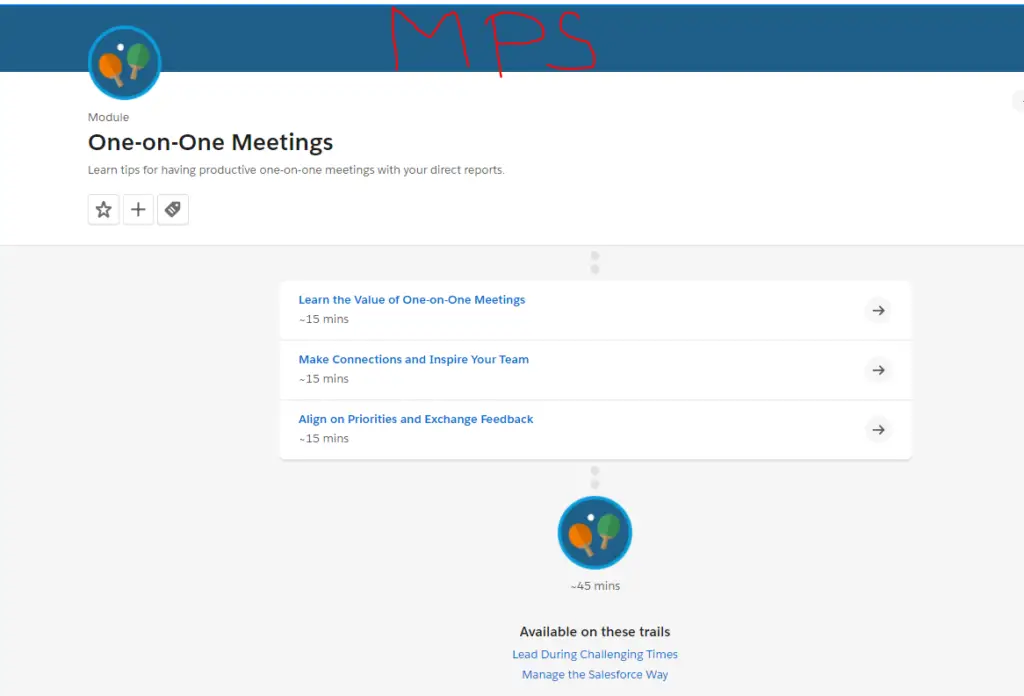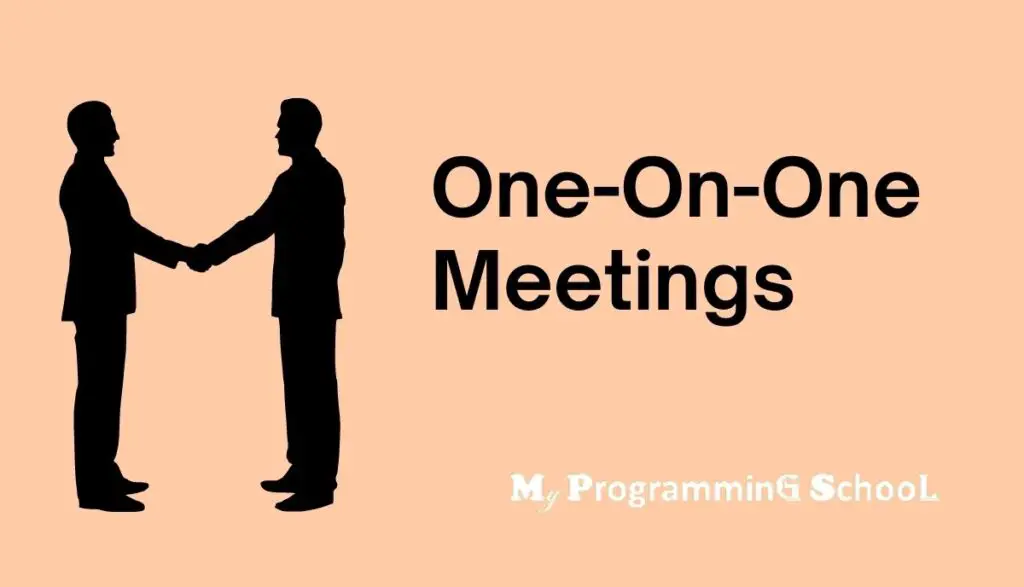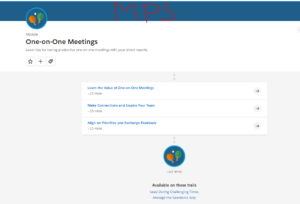One-on-one meetings are a great way to foster a sense of community and strengthen relationships. They also have their own set of rules, which we’ll explore in this article.

#1.Learn the Value of One-on-One Meetings
Q1)When you hold regular 1:1s, your employees are:
I)More productive but slightly less engaged
II)Four times as likely to stay in their position
III)Eight times as likely to stay in their position
IV)More engaged and more productive
[bg_collapse view=”button-green” color=”#4a4949″ expand_text=”Show Answers” collapse_text=”Hide Answers” ]
IV)More engaged and more productive
[/bg_collapse]
Q2)To commit to 1:1s:
I)Assume that your direct report will schedule your 1:1s and other career conversations as needed.
II)Don’t worry about canceling at the last minute to deal with a more urgent business matter.
III)Set a regular cadence and schedule.
IV)Meet your direct report for coffee sporadically.
[bg_collapse view=”button-green” color=”#4a4949″ expand_text=”Show Answers” collapse_text=”Hide Answers” ]
III)Set a regular cadence and schedule.
[/bg_collapse]
Q3)The four elements of effective 1:1s are:
I)Schedule, agenda, status, follow-up
II)Connection, inspiration, alignment, feedback
III)Feedback, marching orders, pass-downs, small talk
IV)Earth, water, air, fire
[bg_collapse view=”button-green” color=”#4a4949″ expand_text=”Show Answers” collapse_text=”Hide Answers” ]
II)Connection, inspiration, alignment, feedback
[/bg_collapse]
#2.Make Connections and Inspire Your Team
Q1)Meeting regularly for 1:1s:
I)Might overwhelm your direct report
II)Isn’t the best use of your time
III)Maintains the trust you’ve built
IV)Is something that’s nice to do but not necessary
[bg_collapse view=”button-green” color=”#4a4949″ expand_text=”Show Answers” collapse_text=”Hide Answers” ]
III)Maintains the trust you’ve built
[/bg_collapse]
Q2)To inspire your direct reports to lead their 1:1 meetings with you:
I)Share ideas about how you prepare for 1:1s with your manager.
II)Take the lead, and then hope your direct reports catch on.
III)Require that 1:1s follow a specific structure and framework.
IV)Share pass-downs from your 1:1 with your manager, and ask your direct report to respond based on what you’ve shared.
[bg_collapse view=”button-green” color=”#4a4949″ expand_text=”Show Answers” collapse_text=”Hide Answers” ]
I)Share ideas about how you prepare for 1:1s with your manager.
[/bg_collapse]
#2.Align on Priorities and Exchange Feedback
Q1)When your direct report is also a manager, which of the following questions would you ask during your 1:1?
I)Which of your reports is your favorite?
II)If you could let one of your reports go this week, who would it be?
III)Whose work habits do you like least?
IV)Who’s going above and beyond expectations this week?
[bg_collapse view=”button-green” color=”#4a4949″ expand_text=”Show Answers” collapse_text=”Hide Answers” ]
IV)Who’s going above and beyond expectations this week?
[/bg_collapse]
Q2)When you’re discussing feedback with your direct reports, which of the following would you recommend?
I)Saving all of it for your 1:1s
II)Asking for feedback on your performance
III)Giving feedback in imperative format
IV)Requiring that they have a solution for constructive feedback by the end of the meeting
[bg_collapse view=”button-green” color=”#4a4949″ expand_text=”Show Answers” collapse_text=”Hide Answers” ]
II)Asking for feedback on your performance
[/bg_collapse]
Q3)Providing support for your direct reports following your 1:1 means:
I)Always being available for questions
II)Following up with them nightly for their feedback and input
III)Taking notes and following up on deliverables between meetings
IV)Always affirming their actions so they feel good about their work
[bg_collapse view=”button-green” color=”#4a4949″ expand_text=”Show Answers” collapse_text=”Hide Answers” ]
III)Taking notes and following up on deliverables between meetings
[/bg_collapse]
Why One-On-One Meetings?
There are benefits and drawbacks to one-on-one meetings. Some people enjoy them and find them necessary for the creation of the trust. However, some people find them unnecessary and annoying. At the same time, there is a psychological theory that says that we create new thoughts during one-on-one meetings more than in any other situation because we’re not distracted by other people’s thoughts.

We should not think of these AI writers as a replacement for human copywriters. They just provide assistance to the content writers by getting rid of writer’s block and generating content ideas at scale.
Artificial Intelligence-powered writing assistants are becoming more and more popular in the workplace as companies of all sizes and specializations invest heavily to keep up with the rapidly changing digital landscape. Some companies use them to generate high-quality content for niche topics or for specific campaigns, while digital agencies use them to generate quality content in bulk.
What are the Benefits of One-On-One Meetings?
One-on-one meetings are a great way to get to know your coworkers, but they also have a number of other benefits.
Here’s a list of some of the advantages:
1. One-on-one meetings provide an opportunity for open and honest discussion.
2. They help you get feedback and support from supervisors and co-workers.
3. They help you identify ways to improve your skills and work performance in order to advance in the company.
4. One-on-one meetings can also help you get connected with people who might be able to help you achieve your goals both inside and outside the company – such as mentors or connections that provide leads for new projects or job opportunities.
Best Practices for Scheduling One-On-One Meetings
The best way to schedule a meeting is by using a scheduling tool. The tools are easy to use and you can set the time slot for the meeting. Plus, it serves as an archive of all your meetings so you can always look back at them if needed.
There are many different types of meeting schedules, but they are all built around two main points – when you want to have the meeting and how long it should be for. Some meetings might only take 15 minutes or less while others might take an hour or more.
Goal Setting
Goals are very important for the success of a meeting. Setting them beforehand will help everyone to know what they are talking about.
There are many different types of goals for meetings. One of them is to set measurable results or objectives – these help you to know how well the meeting went afterward. Another goal could be to make sure that all participants have their voices heard – this way everyone can feel like they played an important role in the meeting.
Agenda
Agenda templates are used by meeting planners to plan the logistics of a meeting. They are typically created in Microsoft Word or PowerPoint and can be customized to suit any business or personal needs.
An agenda template is not complete without the following sections:
● Meeting introductions – This section is for greetings and introductions to members of the meeting. It also includes an introduction of the moderator/facilitator if there is one.
● Agenda – The agenda should include all steps that will be completed during the meeting, including where each segment begins and ends, as well as the time allotted for each part of the discussion.
● Open Discussion – This section provides space for unplanned discussion items that may arise during the course of a meeting. Having this part on an agenda template helps ensure that nothing is missed
Role of the Moderator
We should not think of these AI writers as a replacement for human copywriters. They just provide assistance to the content writers by getting rid of writer’s block and generating content ideas at scale.
AI writing assistants are increasingly getting popular in the workplace. Some companies use them when they need to generate content for a specific topic or niche. While digital agencies use them to generate all kinds of content for their clients.
Types of Meetings and Topics
In a general meeting, the focus is on decision-making. The meeting usually starts with someone bringing up a topic and the attendees of the meeting have to vote on it. In an executive meeting, there is more time allocated to come up with solutions to problems and brainstorm. There are also different types of meetings that can be scheduled at work – for example, a product launch or a team-building session.
Executive meetings are often scheduled for more high-level discussions and decisions on topics that affect the company as a whole. For this reason, they also typically last longer than general meetings do. They’re mostly used for brainstorming ideas and coming up with solutions to problems rather than making actual decisions on those ideas or solving those problems right then and there as in general meetings which are usually quicker.
Credibility Building at Meetings
How to build credibility at meetings?
No matter how well you know your material, it’s always better to build your credibility at a meeting. There are several techniques that can help you do this:
-Provide Context: Before you start talking about the topic, provide some background information and history of it. This will help people understand the issue and they will be more interested in what you have to say.
-Use Visuals: Presenting data or ideas through charts and graphs is an effective way to make them memorable and engaging for the audience.
-Be realistic: providing honest answers to questions and never over-promising or giving unrealistic deadlines. And don’t promise anything that is out of your scope.
Tips on Meeting Etiquette & Communication Skills for Managers and Professionals
Meeting etiquette and communication skills are crucial for managers and professionals. It is important to be aware of the different types of meetings, what they are used for, and how to prepare for them.
Some meeting types include:
- – A team briefing (daily or weekly) where you discuss the day-to-day operations of your group with your team members.
- – A status update meeting where you review the current progress of an ongoing project with your team members. This type can also be used as a status update to senior management or stakeholders.
- – A problem-solving meeting where you come together to discuss how best to resolve a personal issue or project dilemma with your colleagues. The goal is always resolution, not debate.
Tips on attending meetings:
- -Show up on time.
- -Maintain eye contact.
- -Participate in the meeting, but don’t dominate it.
- -End the meeting with an action-oriented conclusion
5 Tips for a More Effective One-On-One Meeting
1. Prepare an agenda
2. Make it clear that you are there to listen
3. Keep the meeting short
4. Follow up with a summary email after the meeting
5. Ask for feedback
Conclusion:
At the end of the day, a one-on-one meeting is an opportunity to get some face time with your boss or coworker. It gives you the chance to share your achievements and discuss any obstacles that are standing in your way. And since it’s not a group setting, you can speak freely about what’s on your mind without worrying about upsetting anyone else in the room. If you have any questions, please contact us today!
